Women in senior positions: India
This is a collection of articles archived for the excellence of their content. |
Contents |
Board members
2014> 2019: an improvement
Oct 11, 2019: The Times of India
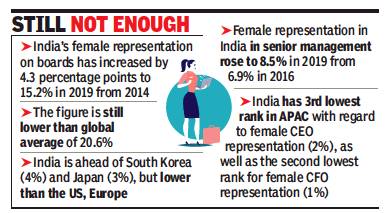
From: Oct 11, 2019: The Times of India
India’s female representation on boards increased by just 4.3 percentage points to 15.2% in 2019 from 2014. This tepid increase shows the serious lag in the country when it comes to female representation in senior management, said the ‘CS Gender 3000’ report by a report from Credit Suisse.
India’s female representation in senior management rose to 8.5% in 2019 from 6.9% in 2016, but not on par with peers. “The proportion of women in management increases as their percentage on boards rises, suggesting that the impact of greater diversity in the boardroom leads to a better gender balance in executive functions. At the 50% level of board representation, we find nearly 30% of women in management,” said the report.
Last year, India made it mandatory for companies to have at least one woman director on their boards. But companies in India seem to be doing the bare minimum to meet regulatory requirement and not taken a holistic approach to ensure gender diversity.
“The countries with the largest representation include those where quotas or less formal targets exist, such as Norway, France, Sweden and Italy. The countries that have seen the biggest proportional increase in boardroom diversity in the last five years — of between 9.4 and 12.8 percentage points — have been Malaysia, France, Australia, Germany and Austria,” said the report.
In APAC, at the top of the table are Philippines (34%), Thailand (28%) and Australia/ New Zealand (25%), and at bottom are India (8.5%), South Korea (4%) and Japan (3%).
But globally there is a lot that remains to be desired. The report said barely 5% of the CS Gender 3000 companies have female CEOs, and less than 15% female CFOs. “Female roles are still clustered away from operational decision-making. A third of all ‘shared services’ functions are held by women, while 80% of heads of IT positions are male,” said the report.
“We are still a long way off in achieving workplace parity. This is why we are keen to spotlight the issues that persist globally and be part of the conversations that can impact material change in the direction of better gender representation and better corporate performance,” said Patsy Doerr, global head of diversity & inclusion, Credit Suisse.
2015>2021
Sep 29, 2021: The Times of India

From: Sep 29, 2021: The Times of India
Women representation on boards in India has increased by 5.9 percentage points over six years, from 11.4% in 2015 to 17.3% in 2021, according to a new gender diversity report from Credit Suisse. However, this number is still significantly below the global average of 24%.
India also saw a slight improvement in management diversity of 2 percentage points over the past two years, rising from 8% in 2019 to 10% in 2021. India holds the third lowest spot in the Asia-Pacific (Apac) region in terms of female representation at the senior management level, slightly ahead of South Korea (8%) and Japan (7%). Similarly, its female representation in CEOs (5%) and CFOs (4%) positions are also low.
Stock market regulator Sebi requires that the top 1,000 listed companies by market capitalisation must have a woman board member who is also an independent director. This mandate has helped to improve women’s numbers at the board level. The report analyses the gender breakdown of 33,000 senior executives from over 3,000 companies across 46 countries, including more than 1,440 companies across 12 markets in Apac.
Europe and North America have the largest share of women in management roles, but the divide between these regions and the rest of the world is far less than at the board level. The gap at the management level is only 1 percentage point. The number of female CEOs globally has increased by 27%, though they still only account for 5.5% of the total.
2014-22

From: Dec 7, 2022: The Times of India
See graphic:
Share of directorships held by women in Nifty-500 cos
Chief executive officers
In India and the world: 2017

From: March 12, 2018: The Times of India

From: March 12, 2018: The Times of India
See graphics:
Women Chief executive officers in India and the world- 2017 (Part I)
Women Chief executive officers in India and the world- 2017 (Part II)
Company directors
2015
The Times of India, Aug 29 2015

Market regulator SEBI in April 2014 mandated that every listed Indian organization should have at exclusive least one woman director on board. Global executive search firm EMA Partners conducted a study to map women directors in the top 200 companies. Of the 2,048 directorships available, 217--or 11% -of board memberships are occupied by women. Of these, 50% are in senior management roles and 36% are civil servants.
Diverse boards outperform male-only by US$14 billion
The Times of India, Oct 14 2015
Diverse boards in India outperform male-only peers by US$14 billion
Indian companies with diverse executive boards outperform peers run by allmale boards according to new research from Grant Thornton.The study titled 'Women in business:the value of diversity' study, which covers listed companies in India,UK and US,estimates the opportunity cost for companies with male-only executive boards (in terms of lower returns on assets) at a staggering US$655 billion in 2014,where India's share is US$ 14 billion.
KEY FINDINGS: In the US,S&P 500 companies with diverse boards outperformed rivals by 1.91%.In the UK FTSE 350,the gap was 0.53% and for the Indian CNX 200,0.85%.This translates into an opportunity cost of US$567bn,US$74bn and US$14bn in each of the three markets respectively or around 3% of GDP in the UK and US; In the UK and US,the impact of moving to mixed boards on the S&P 500 and FTSE 350 could boost GDP by around 3%. The research shows a significant opportunity cost associated with male-only boards:US$655bn for 1,050 companies across the three markets.
RECOMMENDATIONS: Companies: You need to go further and move beyond female participation at a non-executive level.Diversity in decisionmaking boosts performance; Investors:You need to put pressure on companies to diversify their boards at an executive level.There are proven performance benefits. Governments: At a time when productivity is falling,mixed executive teams are generating greater returns from their assets.
2020: Women directors in India and the world

From: February 18, 2020: The Times of India
See graphic:
2020: Women directors in India, China, France, Japan, South Korea, Sweden, the UK and the USA.
Gender diversity laws
2015: Most companies implement gender diversity law
The Times of India, Jan 23 2016
Swati Deshpande
`Women still small part of cos' boards'
A historic gender diversity law did get women onto the boards of nearly 90% Indian companies listed on the National Stock Exchange (NSE), but experts say the spirit of the reform is yet to see the light of day . Only 147 of the 1,451 NSE-listed companies did not comply with the law on April 1, 2015 -the day the mandate to bring at least one woman onto their boards came into force. But the NSE Centre for Excellence in Corporate Governance, in its last report on gender diversity on boards, said the data showed “the unflattering reality that even after the deadline for complying with the woman-director mandate, women still constituted a very small part of the board make-up.“
According to the report's authors N Balasubramanian and Nirmal Mohanty , there is no doubt that the mandate issued by Sebi prompted a spurt in appointments in 2014-15 with 762 women directors and 895 women directorships.
The compliance was also delayed till the last minute by many . Most of the compliant companies in India have only one woman director on board, and she is usually not an independent director, said Afra Afsharipour, a UC Davis law professor. She is in Mumbai for an initiative called the Directors' Collective.
The report says there is a clear paucity of potential independent woman directors. The highest compliance is in Europe with Norway heading the world with 35.5% representation of women on their boards. “But the mindset of companies being an `old boys' club' is slowly changing,“ said Nick Sutcliffe, Asia-Pacific chief of The Conference Board, a not-for-profit group set up in the US to help businesses with best board practices.
Pilots
As in 2022
Ragini Saxena, Bloomberg, August 9, 2022: The Times of India
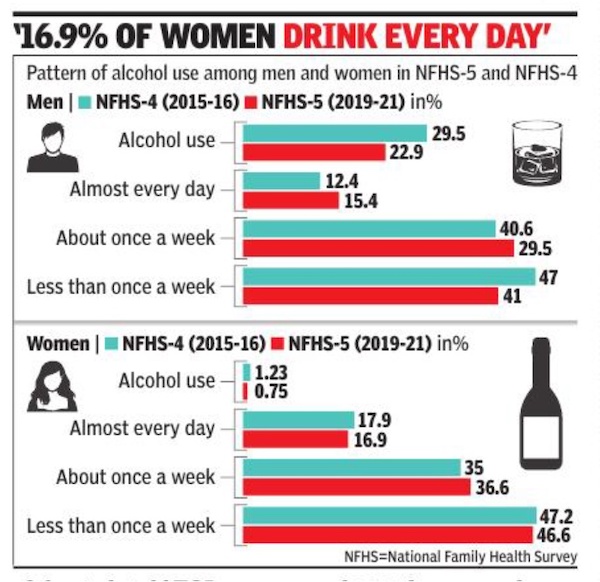
From: Ragini Saxena, Bloomberg, August 9, 2022: The Times of India
Nivedita Bhasin became the world’s youngest commercial airline captain in 1989, but the Indian pilot still recalls her early years when other crew would urge her to rush into the cockpit so passengers wouldn’t get nervous at the sight of a woman flying their plane.
Three decades after Bhasin’s career began, female pilots are no longer a rarity in India, making the country a success story when it comes to diversity in the airline industry. India has the highest percentage of female pilots globally, the International Society of Women Airline Pilots estimates, with about 12.4% of all pilots women, compared with 5.5% in the US, the world’s largest aviation market, and 4.7% in the UK.
The statistics raise questions about how a nation — which placed 135th among 146 countries on the World Economic Forum’s ranking of nations based on gender parity – was able to reverse the trend in this particular industry. Some of the answers may offer lessons for other countries and sectors striving to get more women into their ranks. Businesses that are more diverse tend to perform better, and some studies have even shown that female pilots have fewer safety incidents. Hiring more women could also help airlines address the staff shortages that are disrupting travel as the world emerges from the Covid pandemic and demand rebounds.
Trailblazers like Bhasin say Indian women are being encouraged by a string of factors from outreach programmes to improved corporate policies and strong family support. Many Indian women were drawn to flying through an air wing of the National Cadet Corps, formed in 1948, a kind of youth programme where students are trained to operate microlight aircraft. To make the expensive commercial pilot training more accessible to women, some state governments are subsidising it and companies such as Honda Motor Co. give full scholarships for an 18-month course at an Indian flying school and help them get jobs. “India has started decades ago recruiting women into science, technology, engineering, and mathematics (STEM) positions, including pilots,” said Michele Halleran, a professor and director of diversity initiatives at Embry-Riddle Aeronautical University in Florida. “In the US, we have only started the demand for a diversity movement in aviation because of our current drastic pilot and technician shortage.” The Indian Air Force began recruiting women pilots for helicopters and transport aircraft back in the 1990s. It wasn’t until this year that they were allowed to take up fighter roles.
Some airlines in India are devising policies to retain female talent. IndiGo, India’s largest passenger airline, said it offers flexibility to women pilots and crew to continue working safely, excluding flying duties, during pregnancy. It gives 26 weeks of paid maternity leave that is required under law and also offers creches for childcare. Women pilots can opt for a flexible contract with two weeks' leave in a calendar month, until a child is 5 years old.
Vistara offers pregnant pilots and cabin crew the option of temporary jobs on the ground or administrative roles until they are ready to fly, according to a spokesperson. It also gives paid maternity leave for six months and reimburses creche fees.
Some carriers also assign a driver and guard to drop and pick up women flying late at night, Hana Khan, a commercial pilot with an Indian airline, said.
Many female pilots in India also have a more prosaic explanation for their successes: Family support. India’s familial structure, where extended families often live together and grandparents and aunts often help raise children or manage households, is particularly helpful in an industry that demands long hours and regular travel away from home, pilots say.
“It’s no secret we have the support of parents and it’s a norm to hire staff,” said Zoya Agarwal, who got international media attention when she flew Air India’s first nonstop flight from San Fransisco to Bengaluru with an all-women crew last year. “Women like me can fly to San Fransisco for five days and not think about what’s happening at home. You have that comfort.”
The absolute numbers of women pilots still tend to be higher in developed countries than in India because airline markets in places like the US are much larger, with a bigger total staff of both men and women.
Still, hiring more women can ease a persistent deficit of pilots and airport workers that is forcing airlines to reduce and cancel flights, threatening to snarl the aggressive revival in traffic. Boeing Co. estimates that the world will need more than 600,000 new pilots in the next two decades.
Some believe the benefits might extend even further, and may already be contributing to India’s airline safety rankings, which exceed some developed nations.
The US had almost five times as many fatal air accidents as India since 1945, while the UK has had 15 more deadly incidents, according to Aviation Safety Network.
Air India pilot Zoya Khan says that family support and good house staff — common in India — make it easier for women pilots to work Some of the differences in statistics could simply be the outcome of the US being a larger aviation market than India as more flights increase the probability of accidents. Even so, many pilots believe that having a large percentage of women is at the very least helpful to safety.
A study called Gender Differences In General Aviation Crashes, which assessed airplane and helicopter crash data between 1983 and 1997, found that crash rates for male pilots exceeded that of women. Women operate aircraft “more safely” accounting for only 3% of accidents even as they constituted 10% of all US army helicopter pilots, according to Women in Combat Arms: A Study of the Global War on Terror, which compared the accident rates of men and female pilots from 2002 to 2013.
Bolstering diversity has the potential to make air travel safer because women often take a more measured approach to risk and are therefore involved in fewer accidents than men, said Halleran, the professor at Embry-Riddle Aeronautical University.
Kunjal Bhatt, chief flight instructor at Indian flight school Indira Gandhi Rashtriya Uran Akademi, said she found women trainees particularly “meticulous” and showing greater dedication to succeed because the stakes are higher for those who go against the social norms to pursue this profession.
Indian women who’ve succeeded in the airline industry are educating girls about aviation. Harpreet A De Singh, who became the first woman to head an Indian airline when she took charge of Alliance Air Aviation Ltd. in 2020, conducts outreach programmes in schools to raise awareness about jobs including pilots, technicians and air traffic controllers.
“Over a period of time this consistent effort all over the country has led to large number of women choosing a profession some didn’t even know it existed,” Singh said.
Senior positions
2016, India and the world: An Egon Zehnder report
Namrata Singh, India lags in board gender diversity, Feb 25, 2017: The Times of India
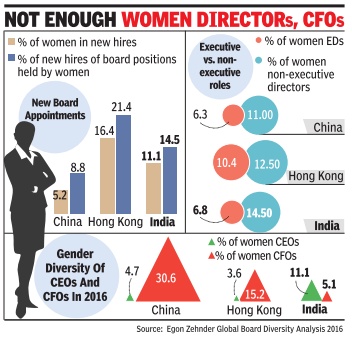
India lags behind Asian markets like China and Hong Kong on certain board gender diversity parameters, despite the best of efforts to bring more women on boards of companies. An Egon Zehnder (EZ) report for 2016 -exclusive to TOI -reveals that India's numbers are lower when it comes to new women board member appointments, women executive directors and women CFOs.
In 2016, new women board member appointments in India stood at 11% of total hires in 2016, as against 14.5% for new male directors. This is lower than the global overall average of 17% women. In other Asian markets like Hong Kong and Malaysia, the same was 16.4% and 27.3%, respectively .
While the compulsion of maintaining one woman director on every listed company board could have helped more women get board positions, the EZ report shows that not many women directors in India have management responsibilities.
Pallavi Kathuria, co-leader of diversity and inclusion practice at EZ, said, “Despite social and economic progress in other areas of the business world, diversity at the leaders hip level, particularly in the boardroom, has not kept pace. Data from the global board diversity analysis and EZ's experiences have shown that, as women start making their voice heard and encourage the de velopment of other women leaders, it is likely that companies will continue increasing female presence on boards.“
Falguni Nayar, founder & CEO, Nykaa, who is on the boards of a few companies in India, said, “To get to where they want to be, women need to lean in. We need to develop abilities to be able to take on the dual responsibilities of career and home. In most cases, this involves increasing risk appetite and pushing oneself forward.“
Nayar said men are comfortable with being on several boards, while women were more conservative in making themselves available for such positions. “However, while the average age of a board would be 55-plus, we are seeing several younger women coming on boards. The attitude is certainly changing,“ said Nayar.
According to the EZ report, India was better than China and Hong Kong on the number of women CEOs. Among CFOs, however, India is far behind at 5.1% of women as CFOs.
2015-22
March 31, 2023: The Times of India
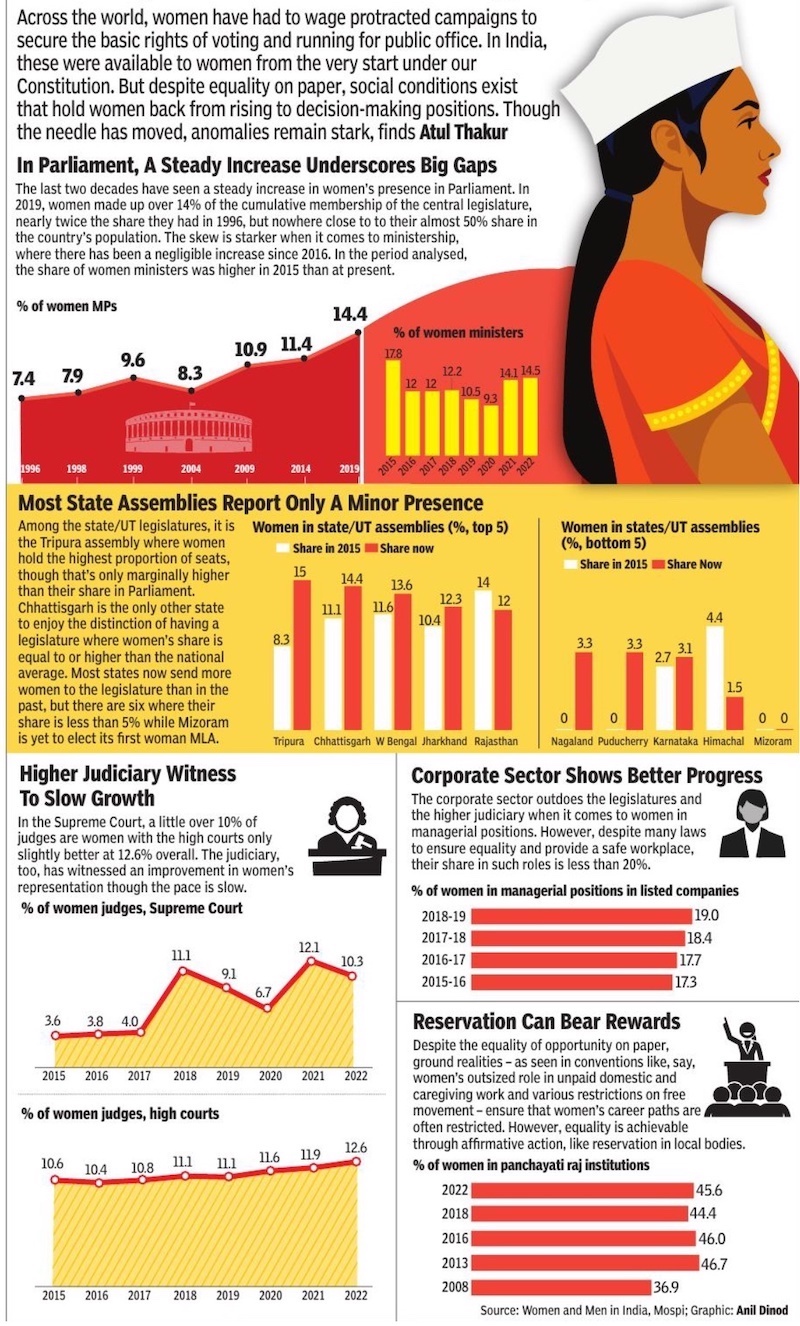
From: March 31, 2023: The Times of India

From: March 31, 2023: The Times of India
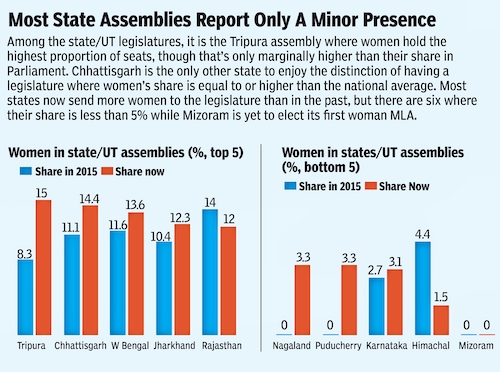
From: March 31, 2023: The Times of India
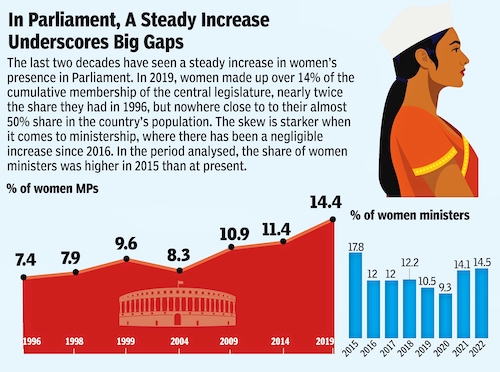
From: March 31, 2023: The Times of India
Across the world, women have had to wage protracted campaigns to secure the basic rights of voting and running for public office. In India, these were available to women from the very start under our Constitution. But despite equality on paper, social conditions exist that hold women back from rising to decision-making positions. Though the needle has moved, anomalies remain stark, finds Atul Thakur
2017: 1 in 5 firms has a female CEO/ top manager
Women head merely 20% of companies globally, April 3, 2018: The Times of India

From: Women head merely 20% of companies globally, April 3, 2018: The Times of India
Women empowerment and feminism have been taking an all-new shape in the past decade. Though there has been observed a positive rise in the education level and job security of women all over the world, especially in developing economies like India, the percentage of women actually heading the companies worldwide is not even one-fourth to that of men.
There was a small rise in the number of women managers in the Indian mutual fund industry in 2017, but they still constitute a mere 8 per cent of the total fund managers in the country, a study by investment research provider Morningstar Inc.’s India unit showed some time back.
Ironically, as per a study conducted by Forbes revealed that it’s actually the companies with more number of women in top management that had a 41 per cent higher return on equity than the remaining others. And yet, today there are actually more male CEOs as compared to women top managers.
But despite all this, on a global level, only 1 in 5 firms worldwide have a female CEO or top manager, and it is a more common phenomenon in smaller firms. Thailand and Cambodia are the only countries where the data shows more women, as compared to men, running the companies.
2018: Hold 7% of crucial positions In BSE 100 cos
Namrata Singh, March 9, 2018: The Times of India
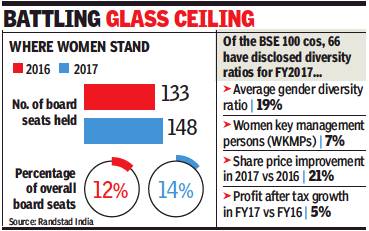
From: Namrata Singh, March 9, 2018: The Times of India
India Inc is walking the talk on gender diversity, especially at key management levels. Building a pipeline and elevating women managers to leadership positions is critical to not only improve upon gender diversity numbers, but also to ensure women managers don’t fall through the cracks as they move up the hierarchy.
Companies are proactively disclosing their diversity numbers along with the number of women key management persons, or WKMPs as they are called. In a BSE 100 companies’ analysis of performance and gender parameters by leading HR service provider Randstad India — done exclusively for TOI — a majority of 66 companies disclosed their diversity ratios, including WKMP numbers, in fiscal year 2017. In the BSE 100, out of a total of 1,039 key management persons (KMP), 76 are women, which is 7%.
Of the 66 companies that have disclosed their gender diversity numbers, 35 have at least one WKMP. Among the remaining 34 companies in the BSE 100 that have not disclosed their gender numbers, 15 have at least one WKMP. In all, there are 50 companies that have at least one WKMP in the BSE 100. Randstad’s research reveals that these 50 companies have shown an overall improvement of 21% in share price in 2017 over 2016.
Although, women are still far outnumbered by their male counterparts at key management levels, there are several indicators that suggest somewhere, in some form, the needle is moving.
‘Cos move towards transparency in gender diversity’
Randstad India MD & CEO Paul Dupuis said, “It is heartening to see that Indian companies are getting increasingly transparent and mature when it comes to details on diversity and inclusion as part of their continuing effort in becoming responsible corporate citizens. According to our research findings, women are represented on the board of every single company that feature in the BSE 100 and there is also a clear uptick in the number of WKMPs in these organisations. This is definitely a move in the positive direction and is a reflection of the fact that diversity has evolved from being just another checklist item. This should augur well for the role of women at the workplace going forward.”
An increase in WKMPs is expected to lead to a strong pipeline of women for directorship roles in future. At present, while the gender diversity ratios at entry levels are more or less balanced, the ratios get skewed towards male employees as one moves up the hierarchies, since a section of women employees leave their careers on attaining motherhood. Bringing women back into the career stream is a key priority for most organisations today.
Recognising the benefits of gender diversity, organisations globally are making several public commitments to make their workplace diverse and inclusive. Deutsche Bank India HR head Madhavi Lall said, “It is no secret that the gender gap widens at the higher echelons of the corporate ladder. So, it is vital to ensure that there is a strong pipeline of female talent. Our gender-neutral parental leave policy and other tailored training and development programmes — focused at the middle and senior management level — have been introduced to address this issue.”
2020
March 4, 2021: The Times of India
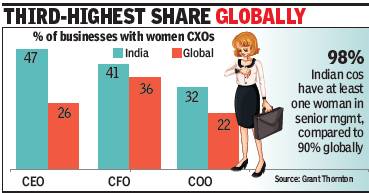
From: March 4, 2021: The Times of India
India ranks third globally in terms of the proportion of women in leadership positions, after the Philippines and South Africa, according to a report by accounting firm Grant Thornton. The percentage of women in senior management for India stood at 39%, as against the global average of 31%, which signals the changing outlook of Indian businesses towards working women, the Women in Business 2021 report said.
The percentage of women leaders across key positions in C-suite in the country also emerged higher than the global average in the report. While globally, businesses with at least one woman in the senior management role increased to 90%, the same stands at 98% in India. In fact, 47% of midmarket businesses in India now have women CEOs compared with 26% globally.
Pallavi Bakhru, partner, Grant Thornton Bharat, said: “Under the challenging circumstances of 2020, the boundaries between work and home have blurred. In this scenario, it is good to see action being taken by businesses to ensure employee engagement and inclusion. 59% businesses in India are promoting work-life balance and flexibility as well as creating an environment where all colleagues can speak up with ideas, issues and questions compared with global average of 45% and 43%, respectively. The businesses are also actively working on their gender balance. 55% of Indian firms are creating equal opportunities at workplace, while 49% are building an inclusive culture, providing mentoring and coaching.”
Data was collated from Grant Thornton’s International Business Report (IBR) — a survey of both listed and privately-held businesses, with 251 companies interviewed in India.
Note: CXO means chief experience officer
The state-wise position
As in 2020
Surojit Gupta, Sep 29, 2021: The Times of India
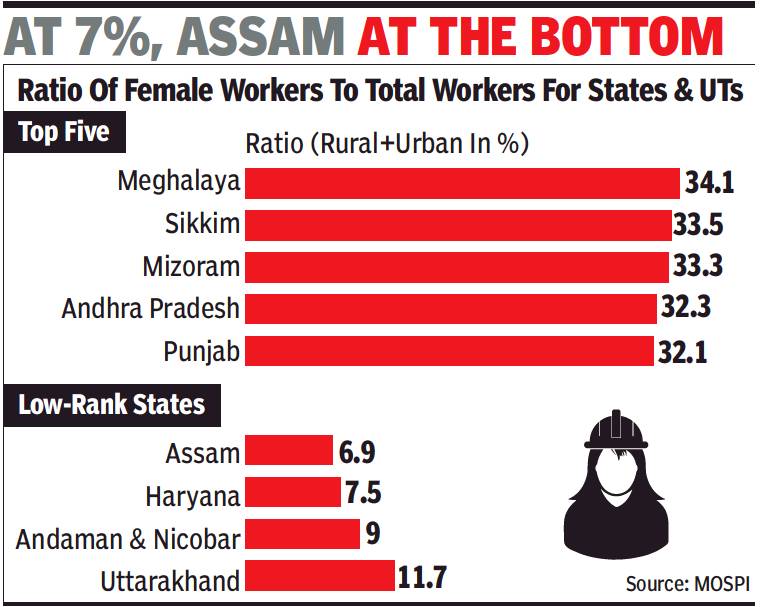
From: Surojit Gupta, Sep 29, 2021: The Times of India
The north-eastern states generally have the highest ratio of female workers in managerial positions, with Meghalaya topping the chart with 34.1%, followed by Sikkim and Mizoram, according to the annual bulletin of the Periodic Labour Force Survey (PLFS).
Andhra Pradesh (32.3%) and Punjab (32.1%) also are among the states with a larger representation of women in managerial positions, while Assam has the lowest ratio of 6.9%. At the all-India level, the ratio of female workers to total workers in managerial positions is at 18.7%. It is at 21.4% in rural and16.4% in urban areas.
The PLFS numbers also revealed that N-E states fare well when it comes to the ratio of female workers working as legislators, senior officials and managers. Manipur tops the list with 51.8%, followed by Meghalaya (51.7%), Sikkim (50.4%) and Andhra (47.9%). Assam again has a lower ratio at 6.2% in this segment.
2021
Surojit Gupta, July 12, 2022: The Times of India
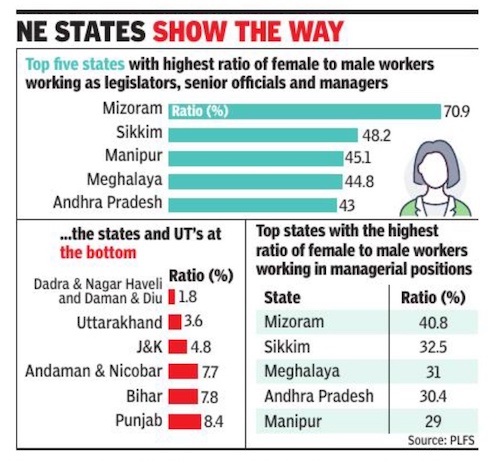
From: Surojit Gupta, July 12, 2022: The Times of India
New Delhi: Mizoram had the highest 70. 9% ratio of female-to-male workers who were working as legislators, senior officials and managers and also the highest proportion of women occupying managerial jobs. Nearly all the northeastern states, barring Nagaland, have strong double-digit representation in senior level jobs, according to the latest additional data in Periodic Labour Force Survey (PLFS) for July 2020-June 2021. Sikkim with 48. 2% and Manipur at 45. 1% made up the top three states. Among the top five states in the category, Andhra Pradesh recorded 43%. The other northeastern state among the top five was Meghalaya with 44. 8%. Assam had 16. 1% while Nagaland had a ratio of 9. 1%. The all India ratio for females to male workers, working as legislators, senior officials and managers, was at 22. 8%. There were several states and Union Territories which had a sharply lower proportion. Among the larger states and Union Territories with a low ratio were Uttarakhand, Jammu and Kashmir, Bihar, Punjab and Andaman and Nicobar. Dadra Nagar Haveli, Daman and Diu had the lowest ratio of 1. 8%. In terms of senior mana- gerial jobs, Mizoram again topped the charts with 40. 8%, followed by Sikkim with 32. 5 and Meghalaya at 31%. Here again, Andhra Pradesh was among the top five with a ratio of 30. 4%. Traditionally northeastern states have had alarger proportion of women in senior managerial jobs. But what is surprising is that Punjab, which had figured among the top states in this category in 2021, recorded a ratio of only 7. 5%. Experts said traditionally the northeastern states have fared much better in terms of female workers’ participation and jobs at the managerial and senior levels. “ It has got to do with education, culture and gender sensitivity. For other states to follow there has to be social transformation across the spectrum,” said Pronab Sen, former chief statistician of India and an eminent economist.
See also
Women in senior corporate positions: India